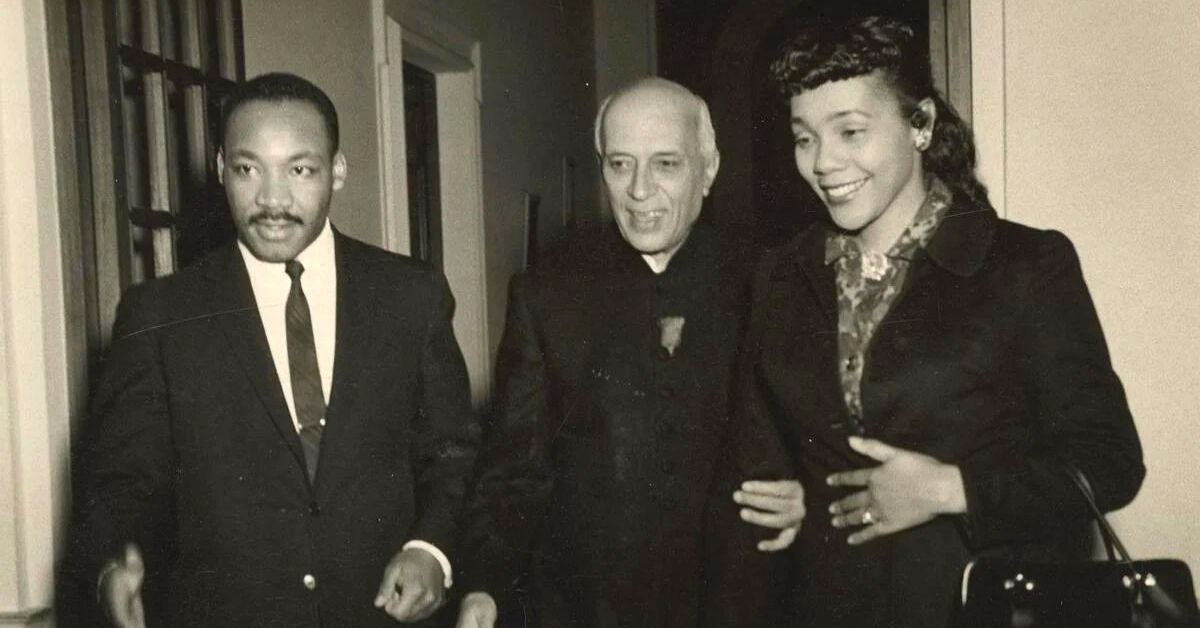Every year on 17 January, the United States celebrates Martin Luther King Jr. Day to commemorate the extraordinary life of the civil rights activist who battled structural racism and inequality in the 20th century.
(Images above courtesy U.S. Embassy India)
A beacon to the African American people, Reverend Dr Martin Luther King, Jr. employed the spirit of nonviolent resistance inspired by the ideals of Mohandas Karamchand Gandhi to challenge White Supremacy which maintains a considerable presence in American life even today. His life’s work not only opened doors that were once closed to African Americans in the US but also inspired other movements around the world against injustice.
One of the lesser-known events of Dr King’s life was his visit to India in the early winter of 1959.
Along with his wife and fellow activist Coretta Scott, Dr King visited the land that had given birth to the man who inspired his nonviolent resistance back home — MK Gandhi.
Received at the Bombay (Mumbai) airport by none other than Prime Minister Jawaharlal Nehru amidst garlands and a crowd of media persons, Dr King reportedly said, “To other countries, I may go as a tourist, but to India, I come as a pilgrim.” He had long harboured dreams of visiting India to witness for himself first-hand the land whose fight for freedom from British rule had inspired his battles back home.
Also, in the words of renowned African American journalist and author Isabel Wilkerson:
“He [Dr King] wanted to see the so-called untouchables, the lowest caste in the ancient Indian caste system, whom he had read of and had sympathy for, and who were left behind after India gained its independence the decade before.”
During the five-week visit to India, Dr King discovered how Indians were “following the trials of his own oppressed people in America”.
After all, he had come to India after famously leading the Montgomery bus boycott, a protest campaign against the policy of racial segregation on the public transit system of Montgomery, Alabama, following the arrest of Rosa Parks, a fellow African American civil rights activist who famously refused to give up her bus seat to a white passenger. Little surprise that during his time in Bombay and Delhi, people would crowd around him on the streets seeking autographs.
During his five-week visit to India, Dr King and his wife went on a trip to Trivandrum (Thiruvananthapuram) in Kerala and visited a high school on 22 February following a luncheon with Chief Minister E. M. S. Namboodiripad.
As he noted in his famous 4 July 1965 sermon delivered at Ebenezer Baptist Church in Atlanta, Georgia, “That afternoon I was to speak in one of the schools, what we would call high schools in our country, and it was a school attended by and large by students who were the children of former untouchables…they could not go places that other people went; they could not do certain things. And this was one of the things that Mahatma Gandhi battled—along with his struggle to end the long night of colonialism—also to end the long night of the caste system and caste untouchability.”

As Dr King stood up to speak, the school principal introduced him to his students in a rather extraordinary way. “Young people, I would like to present to you a fellow untouchable from the United States of America,” the principal said. In his sermon, Dr King recalled feeling “shocked and peeved” at being called an ‘untouchable’ in front of these students.
After all, he travelled halfway across the world and had dinner with India’s Prime Minister. Why would a principal of a school with students from a largely low caste community view him, an African American and a world-renowned activist, as ‘low caste’? He was unable to see why the word ‘untouchable’ applied to him.
That’s when Dr King, as he recalls, harked back to his struggle for racial equality and how as a result of the colour of his skin he couldn’t stay in certain motels in the American South, his children had to study at segregated schools, and that 20 million of his African American brothers and sisters were forced into living in isolated ghettos marked by an “airtight cage of poverty”.
“And I said to myself, ‘Yes, I am an untouchable, and every Negro in the United States of America is an untouchable’. And this is the evilness of segregation: it stigmatizes the segregated as an untouchable in a caste system,” said Dr King.
It was then that Dr King realised how America had imposed a caste system of its own that wasn’t very different from the caste system practised in India and that he had lived and endured in this system all his life. This system stood at the very foundation of the evil forces he was fighting in America.
As Isabel Wilkerson notes in her deeply insightful New York Times essay:
“In the United States, racism and casteism frequently occur at the same time or overlap or figure into the same scenario. Casteism is about positioning and restricting those positions, vis-à-vis others. What race and its precursor, racism, do extraordinarily well is to confuse and distract from the underlying structural and more powerful Sith lord of caste. Like the cast on a broken arm, like the cast in a play, a caste system holds everyone in a fixed place.”
Following his visit to India, Dr King would go on to do even more extraordinary things in the struggle for civil rights in America before his brutal assassination on 4 April 1968. But what happened on that day in a Kerala school created an awakening that some might suspect gave further clarity to his struggle against racial inequality and injustice.
Sources:
https://www.nytimes.com/2020/07/01/magazine/isabel-wilkerson-caste.html
(Edited by Yoshita Rao)
No comments:
Post a Comment